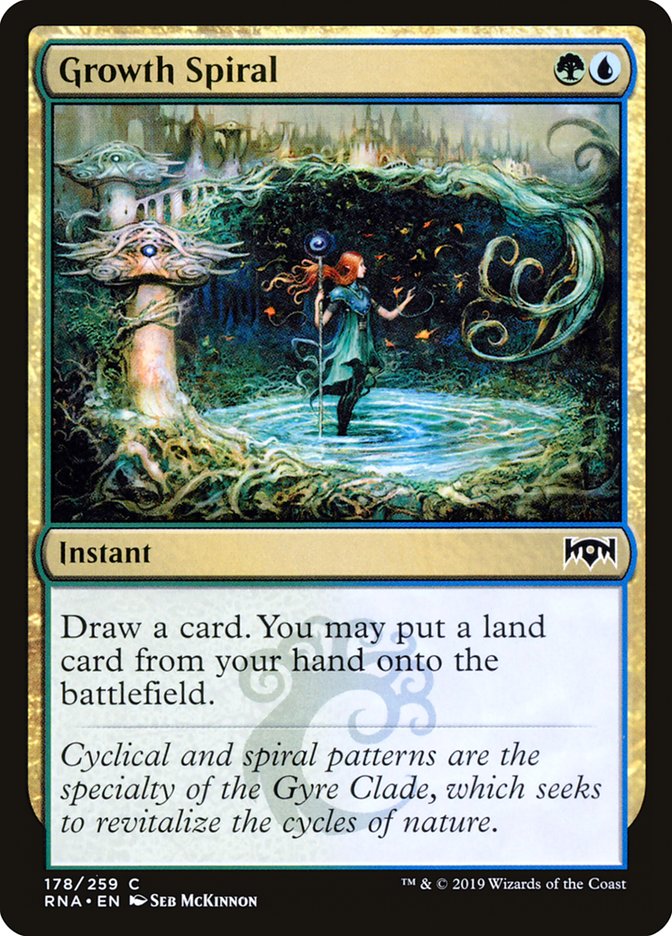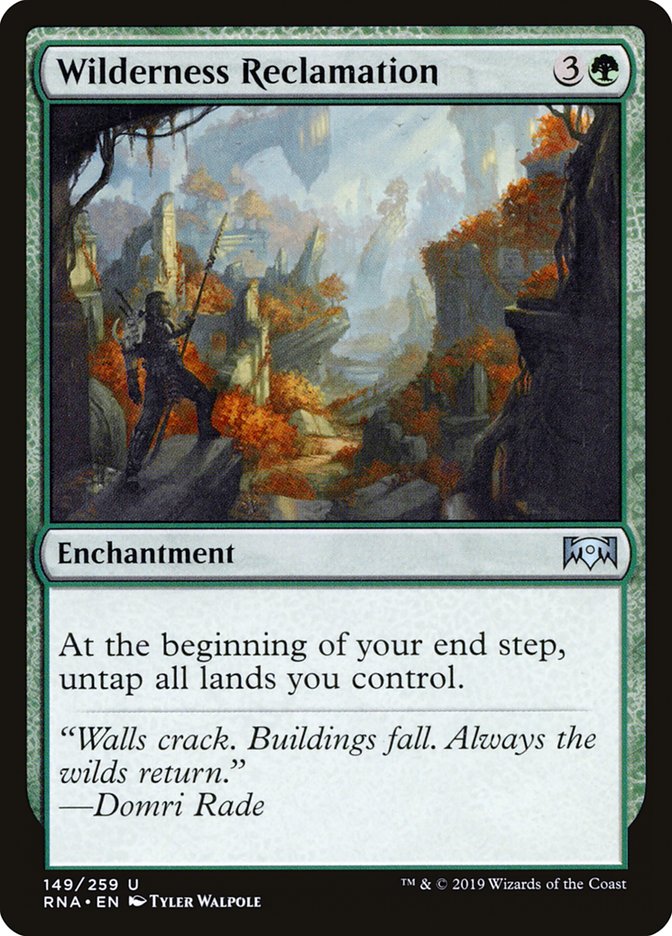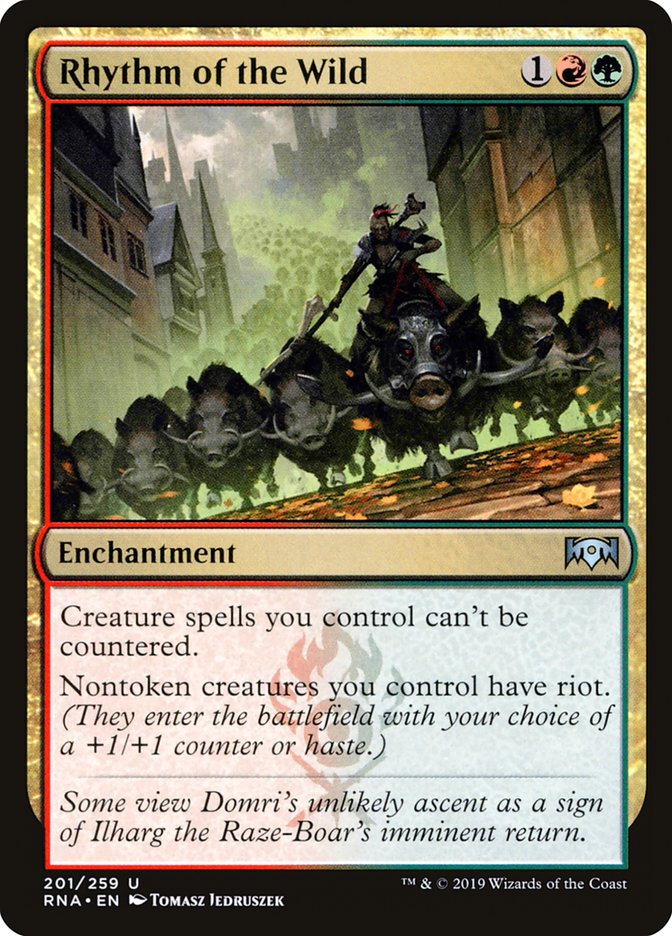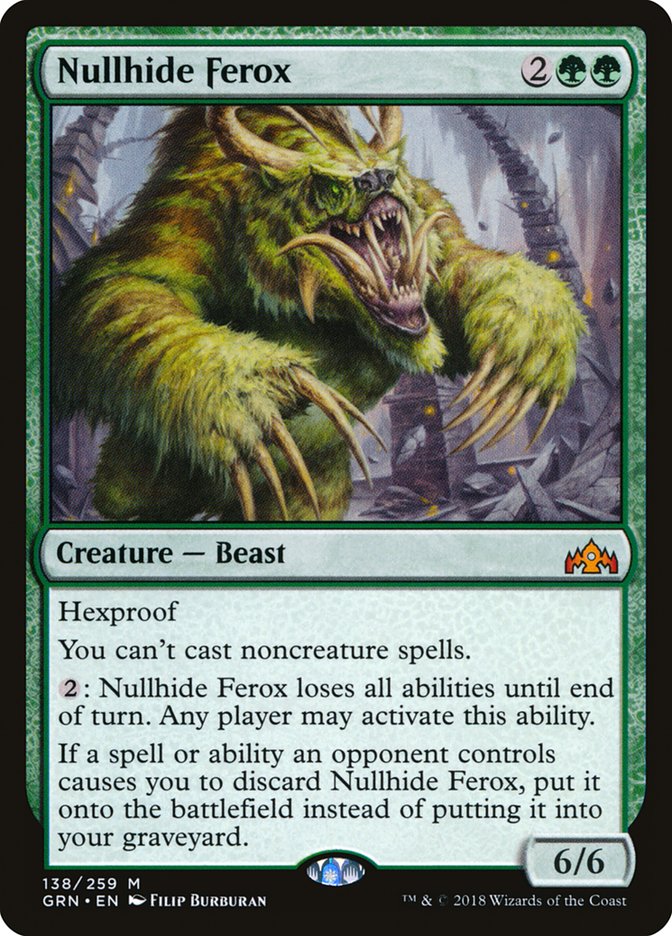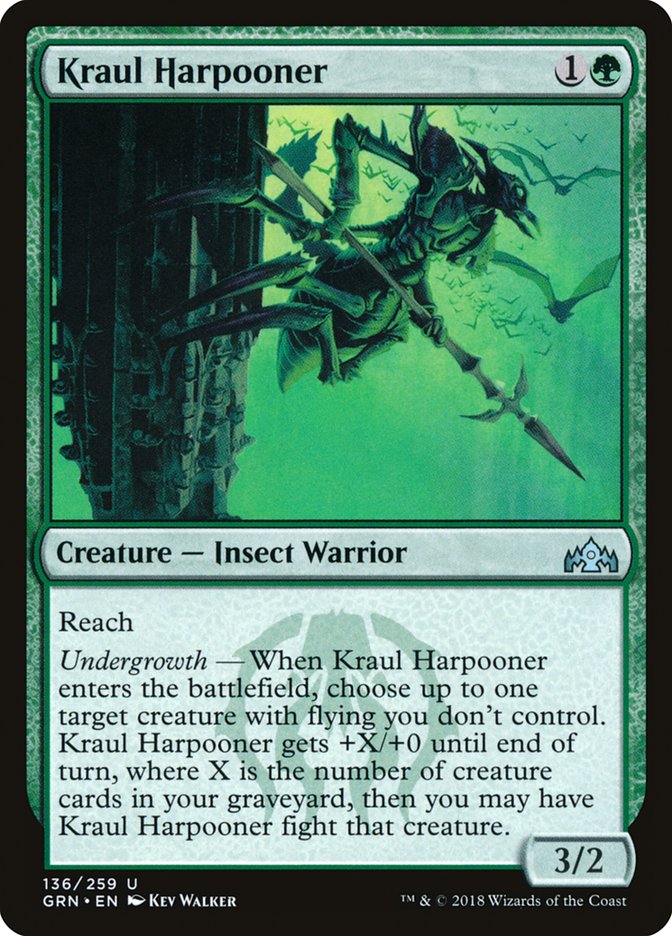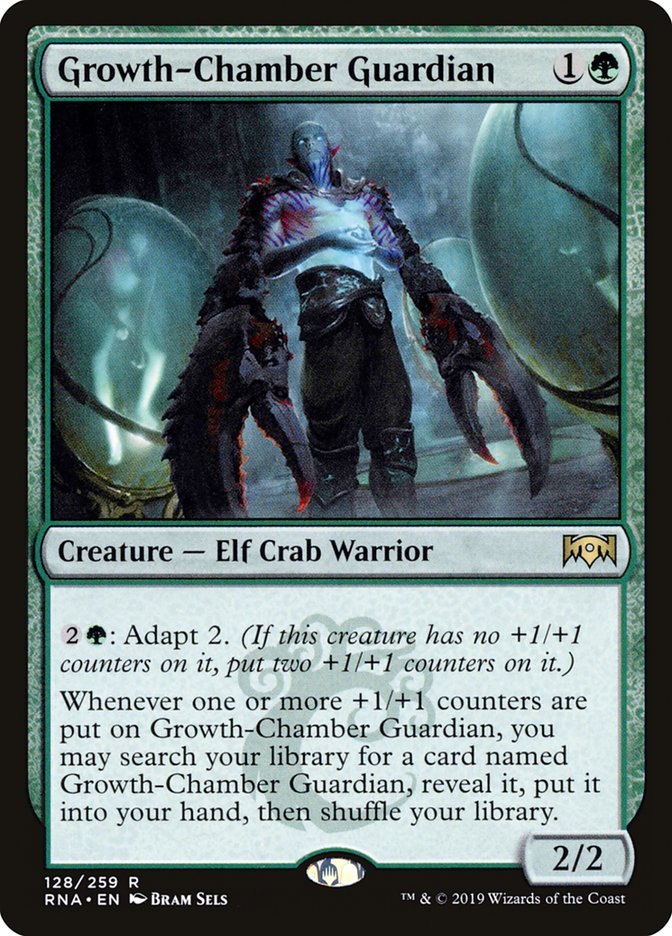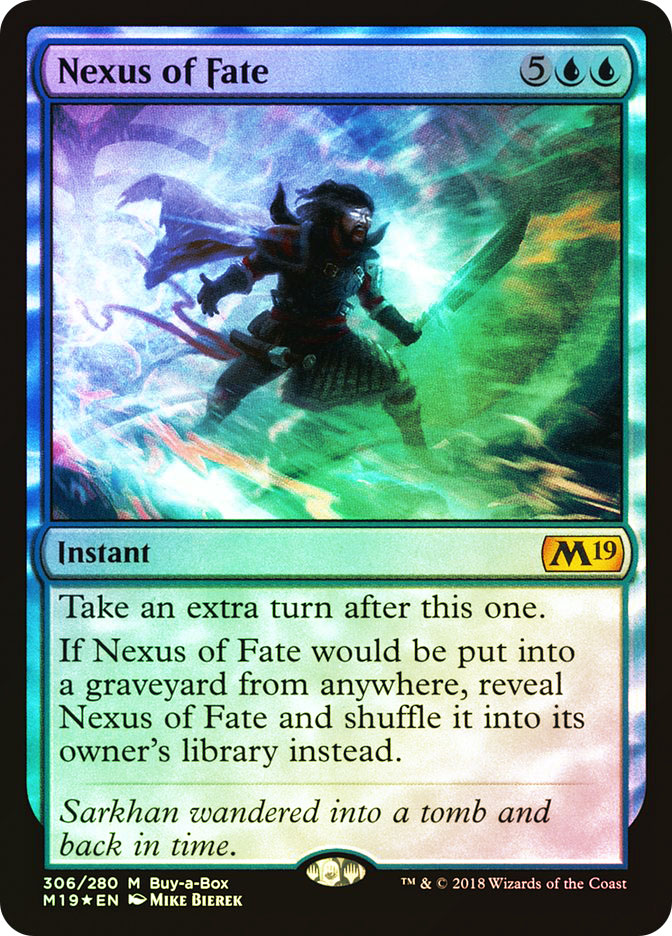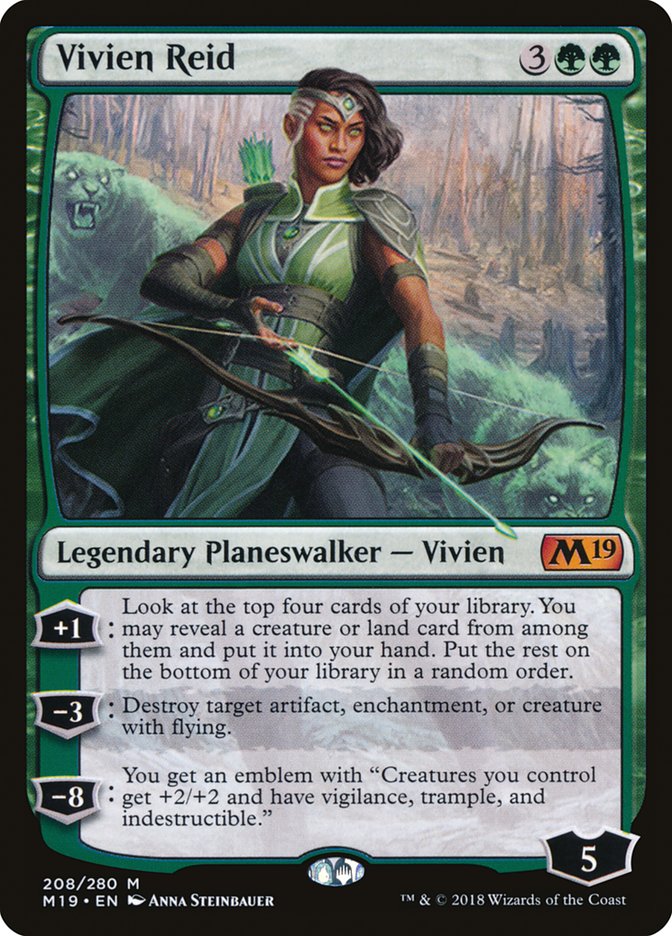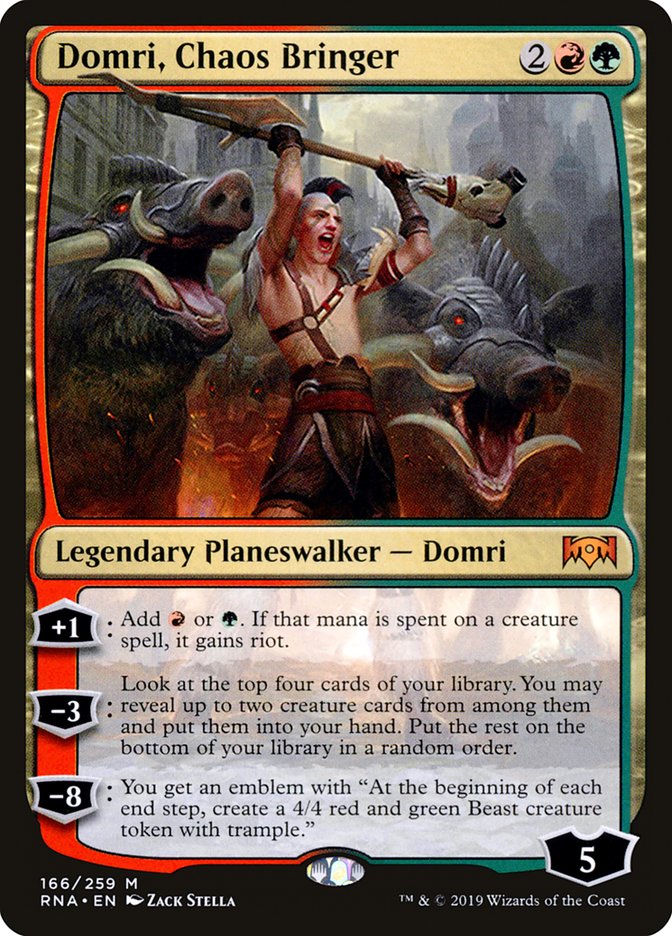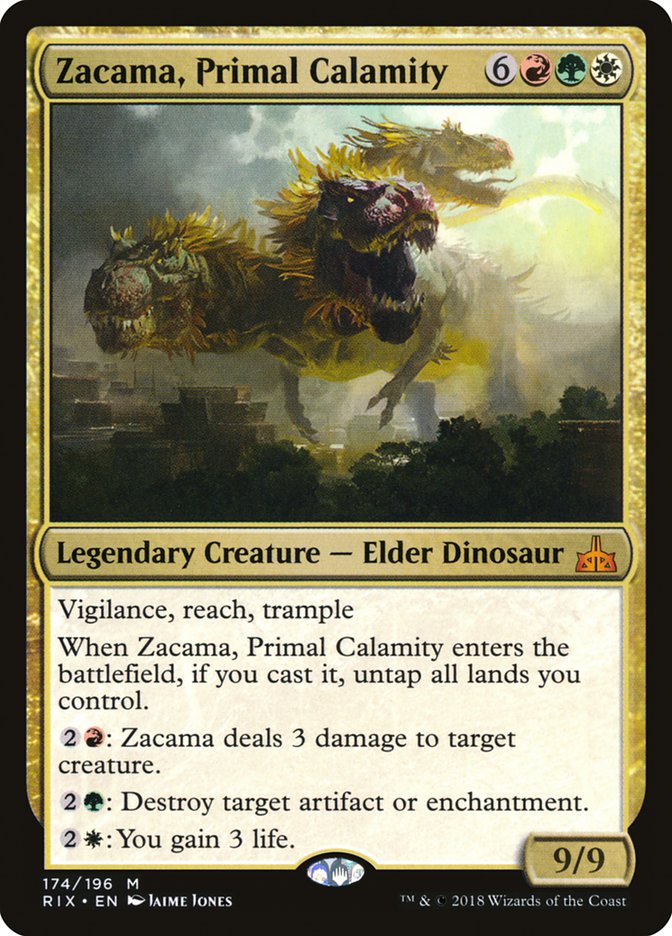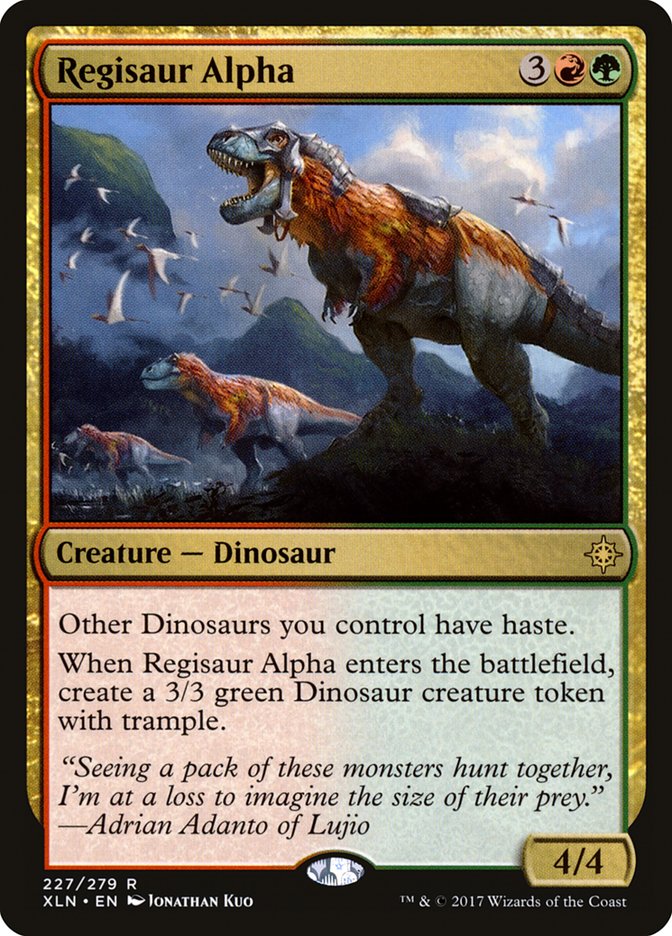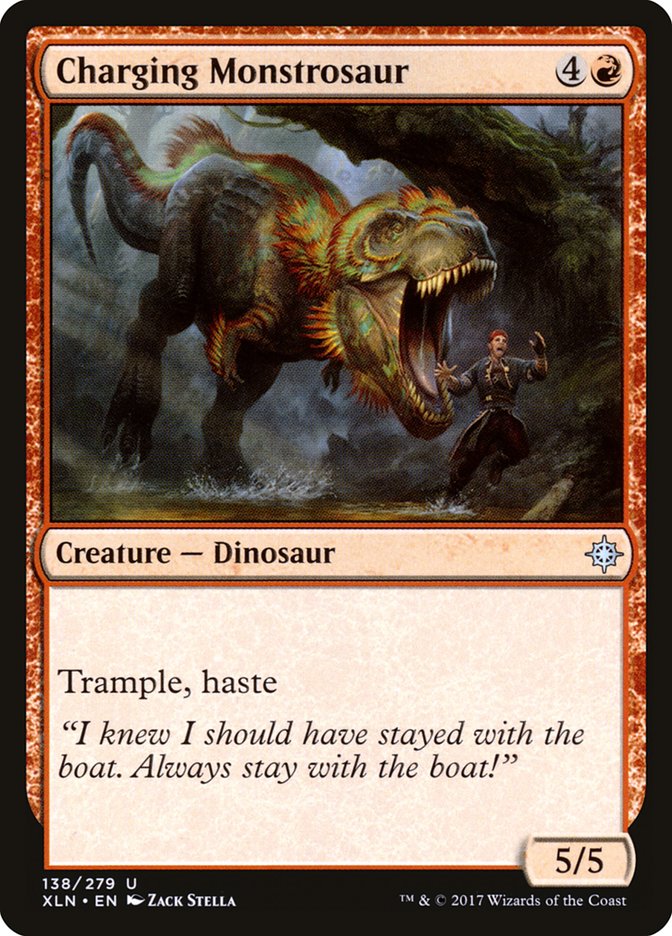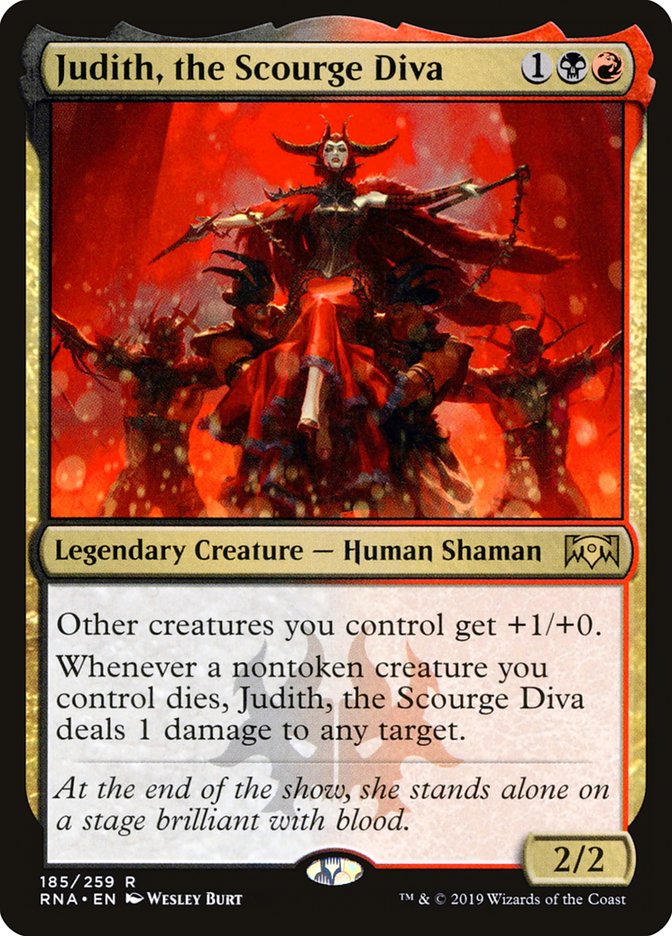I’ll be honest: I didn’t look too closely at the implications of Rhythm of
the Wild when previews for Ravnica Allegiance started getting
heavy last week. I was caught up in a Modern and Legacy mindset, thinking
about cards like Lavinia, Azorius Renegade, Sphinx of Foresight, and
Electrodominance in the context of Magic’s more powered up formats. The
biggest cards of interest to me for Standard were Growth Spiral and
Wilderness Reclamation for creating a Bant Nexus deck to prey on
unsuspecting opponents. Even then, I decided to leave the Bant brewing up
to my friends and colleagues Marcus Luong and Rob Pisano, trusting that
they would have a lot of fun figuring out the best way to abuse Nexus of
Fate.
At MagicFest Oakland this past weekend, though, an offhand remark by Jarvis
Yu got the wheels turning in my head about a more aggressive take on
Standard.
“Rhythm of the Wild means that you can get multiple instances of riot,
which stack. I think that’s way better than the original Fires of
Yavimaya.”
Can’t be countered? Massive, hasty monsters? Sign me up for a quick
beatdown plan with that kind of offer!
Nearly twenty years ago, Zvi Mowshowitz wrote an article series called “My
Fires” that laid down the meticulous details of every part of his Fires of
Yavimaya deck from Pro Tour Chicago, from Karplusan Forest to Two-Headed
Dragon. Times have changed since Invasion was released, but if
Fires of Yavimaya could be worth ten thousand words, surely the far better
Rhythm of the Wild is worth at least an article about how to properly
maximize its power. After all, Rhythm of the Wild offers haste when you
need to deal damage quickly, and +1/+1 counters when you need to size up to
create an impregnable battlefield. That kind of choice is incredibly
powerful.
So what do we make of it?
We start, of course, with the only remaining legal member of Standard who
came along from times of yore with this Fires of Yavimaya upgrade. Llanowar
Elves will continue to cast this busted enchantment on turn 2 just as it
did so long ago. Though I’m not astonished at the lack of Llanowar Elves in
most Golgari lists lately, as the card doesn’t quite curve out properly
with Wildgrowth Walker and offers a poor lategame topdeck, its power is
much more in line with Rhythm of the Wild and a Gruul Monsters-style deck
than grindy Golgari. Llanowar Elves will be a huge cog in Standard, but
it’s simply taken a bit more in the way of powerful three-mana payoffs to
really bring out that role.
From that point, we have a key choice. Do we want to commit to a heavy
green manabase and obtain the powerful payoff of Steel Leaf Champion, or
would we prefer to go more middle-of-the-road with some number of Mountains
and more double-red spells available to us? Skarrgan Hellkite or Steel Leaf
Champion? It seems possible but greedy to try and fit both into a deck with
only Rootbound Crag and Stomping Ground to stitch things together. Are we
going to be the Mono-Green Aggro deck from last format with just ten red
sources for Rhythm of the Wild, or will we be a more middle-of-the-road
Gruul deck? And, crucially, which two-drop do we prefer: Thorn Lieutenant
or Zhur-Taa Goblin? Or is there something even better? (Hint: There is.)
Regardless, Nullhide Ferox and Kraul Harpooner deserve consideration in
this deck as holdovers from the first Mono-Green Aggro sketches of last
year. Can you imagine bashing an opponent with a hasty Ferox on turn 3? Or
punching down a 2/4 Crackling Drake with your new 4/3 Kraul Harpooner?
Undergrowth on the Harpooner, specifically, works wonders with the haste
granted from riot. A topdecked 7/2 haste creature on turn 6 or 7 is often
going to pull a game across the finish line even as an opponent is starting
to gain control. Of course, we’ll also be playing Gruul Spellbreaker, and
we’ll likely want Ghalta, Primal Hunger to come down and smack an opponent
for twelve hasty trampling damage sometime in the middle turns. And yes, as
our supplementary one-drop creature we’ll probably go straight to Pelt
Collector as a creature that can quickly size up to 4/4 or larger,
especially with errant +1/+1 counters flying around from all the rioting
going on.
Oh, and one more thing. Legion Warboss. We have Llanowar Elves to power out
our new Goblin Rabblemaster on turn 2 consistently, despite not having
synergy between the tokens and Rhythm of the Wild. I’m willing to consider
any incentives to lean away from the heavy green commitment for Steel Leaf
Champion and embrace red, and a standalone army-producer might be something
we’re interested in.
But if we are interested in incredible synergy with Rhythm of the Wild,
yes, there is something better. We need look no further than Growth-Chamber
Guardian.
Read it carefully.
If you cast a Growth-Chamber Guardian and riot it up to a 3/3, you
immediately find another one. You can chain together all your Guardians
very quickly for only two mana a pop and recover from a sweeper. Or, if you
have spare mana, you can simply give your Guardian haste and immediately
adapt it up to a 4/4, chaining 4/4 haste creatures out of your deck every
turn until your opponent concedes. This is not a format conducive to
surviving an aggro rush and then winning at your leisure after the opponent
is all gassed out. This format will have very resilient threats, threats
that replace themselves and make traditional removal look silly.
It’s also not a format where Teferi can run wild, at least compared to
previous ones. Planeswalkers and haste creatures exist in a very
interesting equilibrium, where the more prevalent haste is, the worse and
worse Planeswalkers become. We saw this with Jace, the Mind Sculptor and
Bloodbraid Elf. We’ll see it again with Teferi, Hero of Dominaria and
Rhythm of the Wild.
Traditional Jeskai Control is going to get demolished in this new world,
and I expect the way for Teferi, Hero of Dominaria to retain his throne
will be through Nexus of Fate and Fog effects.
The big picture issues on my mind with this very straightforward (and
likely very powerful) beatdown deck are a difficulty removing must-kill
creatures without dipping into too many noncreature spells and diluting the
effectiveness of Nullhide Ferox and Rhythm of the Wild. After all, losing
to multiple Benalish Marshals or a Curious Obsession on a Siren Stormtamer
is never a fun experience. My kingdom for a Heart-Piercer Manticore!
As such, I’m looking at cards like Goblin Cratermaker, Territorial
Allosaurus, or even Atzocan Archer (I know) to offer some sort of
interaction without having to dip into noncreature spells. Obviously
Thrashing Brontodon is wonderful here to interact with troublesome
permanents like Wilderness Reclamation or Gift of Paradise.
Of course, we are permitted to play Vivien Reid or Domri, Chaos Bringer
instead of Nullhide Ferox or in the sideboard to swap in for the big 6/6,
but my instinct is that Rhythm of the Wild is worth a lot of commitment,
and as the only noncreature spell in the deck, it offers the largest
benefit.
Here’s where I’m currently at with “My Rhythm,” and I hope Zvi enjoys the
homage even after all these years:
Creatures (32)
- 4 Llanowar Elves
- 2 Merfolk Branchwalker
- 2 Ghalta, Primal Hunger
- 4 Steel Leaf Champion
- 4 Nullhide Ferox
- 4 Kraul Harpooner
- 4 Pelt Collector
- 4 Gruul Spellbreaker
- 4 Growth-Chamber Guardian
Lands (24)
Spells (4)
Sideboard

We’re just running an all-in beatdown plan, the hell with the consequences.
It’s the Gruul way. The sideboard is hoping to catch some folks on
Mono-Blue Aggro with a heavy dose of removal in Reclamation Sage and
Thrashing Brontodon for the Curious Obsession. Atzocan Archer and
Cratermaker combine with Kraul Harpooner to clean up the miniature flyers
and do great work against Boros Aggro as well. For fighting Bant Nexus
decks, we’re relying on the Disenchant creatures to prevent them from
gaining a massive mana advantage, and our hasty monsters to kill Teferi
before he gets too out of control.
Of course, straight Gruul isn’t necessarily the only way to play with
Rhythm of the Wild. We live in a world where a deck can confidently play
the following manabase:
3 Forest
With eleven ways to cast a turn 1 Llanowar Elves and a full thirteen blue
and red sources, this manabase offers a high level of consistency for a
Temur deck that wants to play a handful of counterspells (and is willing to
give up Steel Leaf Champion and Nullhide Ferox to do so!)
Jund, Temur, and Naya are all options on the table, and each brings with it
some strengths and weaknesses.
Temur offers a smattering of countermagic; Jund offers discard and Judith,
the Scourge Diva (which does help with the “no removal in an all-creature
deck” problem); and Naya…well, Naya offers a few Dinosaurs from Ixalan, topping out with Zacama, Primal Calamity, I suppose!
But no, it’s not Zacama bringing us to think about Dinosaurs as a serious
shell for Rhythm of the Wild. One of the benefits of playing Dinosaurs is
getting to play with additional mana accelerators like Drover of the Mighty
and topping out with Carnage Tyrant. What’s scarier than a Carnage Tyrant
on turn 4? A Carnage Tyrant with haste on turn 4! Combining two mana
accelerators with a Rhythm of the Wild means your opponent may be biting
the dust to a big Dinosaur very, very early in the game.
Unfortunately, there’s not a huge amount of synergy between the best
Dinosaurs and Rhythm of the Wild, as Regisaur Alpha and Charging
Monstrosaur already make for a lot of haste, and the creatures are already
massive enough to run over basically anything an opponent could put in
their way. This is very non-intuitive when comparing Rhythm of the Wild
with Fires of Yavimaya, which was at its best when combined with big
creatures like Two-Headed Dragon and Blastoderm. Sure, Ghalta still loves a
bit of haste now and then, but the difference between a 12/12 and a 13/13
is negligible, and Regisaur Alpha already provides Ghalta with everything
she needs to get to business right away.
No, if we’re going to maximize this enchantment, it will be with the
lower-end Gruul creatures, possibly in concert with Judith, the Scourge
Diva. Sideboard Duress and associated disruptive creatures also offer a lot
more real interaction for control than we might otherwise get, and provided
you can massage the manabase appropriately, Ravenous Chupacabra offers the
best Flametongue Kavu we’re going to see for this type of deck in
contemporary Standard.
For such a deck, it behooves us to wait and see what else Rakdos is going
to offer us to combine with Rhythm of the Wild, but Ari Lax has a
good start
on a rough sketch involving using Find in concert with Glowspore Shaman and
the explore creatures (Merfolk Branchwalker and Jadelight Ranger) to bring
back Kraul Harpooner and attack for a large amount of damage immediately.
It’s entirely possible that Rhythm of the Wild ends up being the most
impactful card in Standard from Ravnica Allegiance. Giving your
entire team the better of haste or a Glorious Anthem effect as you see fit
is just an impressive return from a three-mana enchantment, and the fact
that they work well in multiples is icing on the cake. I look forward to a
more layered collection of aggressive decks in new Standard now that Boros
isn’t the only guild beating down.


